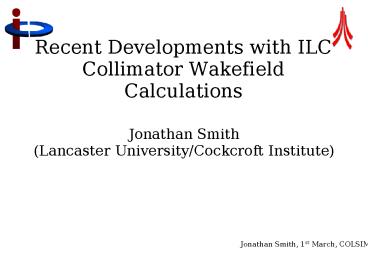Recent Developments with ILC Collimator Wakefield Calculations - PowerPoint PPT Presentation
1 / 28
Title:
Recent Developments with ILC Collimator Wakefield Calculations
Description:
Collimation is crucial for beam delivery and detector protection/performance of ... semi-circle, with[9]/without[10] flat, opposing demi-circles[10], 8 with flat[11] ... – PowerPoint PPT presentation
Number of Views:32
Avg rating:3.0/5.0
Title: Recent Developments with ILC Collimator Wakefield Calculations
1
Recent Developments with ILC Collimator Wakefield
Calculations
- Jonathan Smith
- (Lancaster University/Cockcroft Institute)
2
Introduction/Project Objectives
- LC-ABD WP5.3 (Nigel Watson)/EUROTeV WP2 (BDS)
- Collimation is crucial for beam delivery and
detector protection/performance of a particle
accelerator - Quantification of longitudinal and transverse
wakefield effects of collimators on the beam - Optimization of collimator design
- Use and understanding of simulation tools,
potential improvements and support of other
projects - Verification by test beam measurement
3
Wakefield box
Slide reproduced from talk by Nigel Watson
ESA ?z 300?m ILC nominal ?y 100?m
(Frank/Deepa design)
Ebeam28.5GeV
Magnet mover, y range ????mm, precision 1?m
4
?
r1/2 gap
As per last set in Sector 2, commissioning
Extend last set, smaller r, resistive WF in Cu
7mm
cf. same r, tapered
Slide reproduced from talk by Nigel Watson
5
Slide reproduced from talk by Nigel Watson
6
Run 1206 (ref. 1207)
Multiplying each bunch by its ebpm_x ADC value
Small improvement on the Chisq/n
7
Analytical estimate
- Stupakov says
- Stupakov says
- Stupakov says
- Stupakov says
- Stupakov asserts that the hb is met, but is this
really valid?
8
For SLAC collimators...
9
Assessment/Familiarization of Simulation Tools
- MAGIC (easy to use tool for first comparison with
new calculations) - ECHO/ECHO3D
- Thomas Weiland, Mikko Karkkainen (TEMF,
Darmstadt) Igor Zagorodnov (DESY). Code
development as part of EUROTeV project - MAFIA
- CDB and JS working on comparison with Cho Ngs
results (PAC 2001) - GdfidL
- Overlapping interest with David Miller and Alexei
Liapine (UCL) as part of EUROTeV WP5
(Spectrometry) - Additional software for research if required
- BCI/TBCI/ABCI (old CERN tools), XWAKE, XOOPIC
- Tau3P, Omega, T3P (next generation SLAC codes)
- Boundary Element (BEM) codes (Sapporo, Japan)
10
EM Simulations with GdfidL
4
5
2
7
1
6
8
3
11
Wakefields _at_300µm
- (6 cells/sigma)
12
Wakefields _at_500µm
- (12 cells/sigma)
13
Mesh stability Collimators 12
- Only 3 decent points at 300µm for most
collimators - More at 500µm
- 1mm OK can use spline fit on data to get an
estimate not done so far further analysis to
see if this takes us closer to ECHO/PBCI.
14
What do we do about it? (1)
15
What do we do about it?(2)
16
Effect of mesh filtering
17
Misallignment
18
Further collimator designs
semi-circle, with9/without10 flat, opposing
demi-circles10, 8 with flat11.
19
More possible collimators
7 with flat 13, half exponential14, 13 with
shallower angle15 exponential profile16, 13
with ellipse connecting 4mm and 1.4mm
aperture17 13 with ellipse connecting beam pipe
radius and 1.4mm aperture (also see 9)18 half
cosine taper 19, raised cosine taper 20, tanh
tapers 21 (set typically to the length of
collimator 6)
20
Exists, from 2006 runs. For reproducibility
Runs 3, 2007
Roughened surface, compare with 12
As 10, in Ti-6Al-4V, polished, cf. 12
As 10, in OFE Cu, polished, cf. collim. 6, 13
21
OFE Cu
Polished, cf. collim. 7, 12, 13
Ti6Al4V
0.6??? Ti6Al4V
Runs 3, 2007
Polished, cf. collims. 7, 11, 13
Polished, cf. collim. 13
OFE Cu
Form t.b.d.
cf. ?
22
Variation of collimator kick with bunch length
23
WB's suggestion
Chop this bit off as beam will never see wake
that has travelled this far from the bunch
24
Two possibilities
colimator 22
colimator 23
25
Longitudinally Asymmetric?
26
Results...
27
Cylindrical jobs...
- W modal decomposition
- See Adriana's talk...
- Jobs still running
- w(s,r,r',?,?')?w(s,r,?,m)
- Useful for rectangular geometry?
28
GdfidL PBCI
- TEMF working on ECHO/PBCI 3D, moving mesh,
conformal, non-dispersive solver
GdfidL
s/?z6
PBCI
W(s)/(V/pC)
With thanks to Mikko Kärkkäinen
s/s

